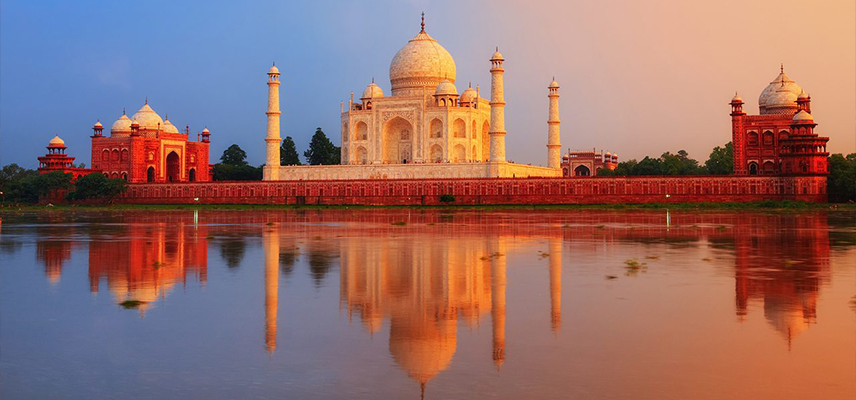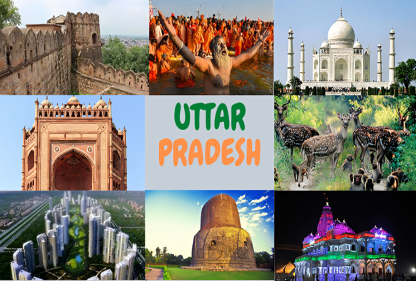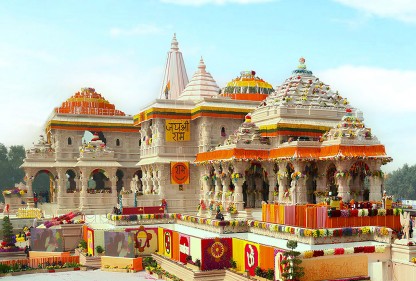Uttar Pradesh
Situated right in the centre of India, Uttar Pradesh is home to some of the most ancient cities that have shaped a distinctive culture and ethnicity for the state
UTTAR PRADESH
Situated right in the centre of India, Uttar Pradesh is home to some of the most ancient cities that have shaped a distinctive culture and ethnicity for the state. Thriving through the multiple religious communities, the state has some of the most striking temples representing Hinduism and Buddhism. One of the most prized possessions of the state has to be the Taj Mahal, listed in the seven wonders of the world. No matter where you travel in the country, you cannot leave without visiting the iconic Taj Mahal. This symbol of love shining with the backdrop of Yamuna river makes up for a beautiful sight for your book of memories. Furthermore, there are many monuments like Fatehpur Sikri, forts and temples that attract one's attention in the state. The historic cities of Varanasi, Kanpur, Ayodhya, Prayagraj, Lucknow among others offer an enticing combination of vibrant culture, local beliefs and ancient stories. While many simply stick to the grandeur of the Taj Mahal, or visit the ghats in Varanasi, the state goes beyond these two cities in retelling the tales of our country. Home to the royal Nawabi cuisine, you can also visit Lucknow to experience its royal charm and indulge in the local cuisine. With a strong royal presence in the realms of dance, music, and the arts, the state also boasts of Kathak, one of India's original classical dances. As India’s most populous state, the state hosts numerous fairs and festivals that celebrate the various cultures and customs. With a history dating back to almost 4000 years, Uttar Pradesh has beautifully emerged as a collection of stories that you would want to experience firsthand. Here we dive into all the major attractions of the state and what else you should not miss while visiting Uttar Pradesh.
Eye-Catching Places to Visit in Uttar Pradesh
Agra
Located on the banks of the river Yamuna, once a jewel in the Mughal reign, Agra’s essence lies in the stories defined through its monuments. Home to the majestic Taj Mahal, it also has two more UNESCO World Heritage sites, the Agra Fort and Fatehpur Sikri that provide a glimpse into the legacy of the Mughal dynasty. The city is significant not only to the Mughal empire, but also to the Mahabharata, making it a crucial site for Hindus and Muslims in India and the Indo Aryan
Lucknow
The capital city Lucknow is the best combination of Kebabs (local delicacy) and Nawabs (royals). Situated on the banks of the river Gomti, the city used to be the cultural capital of Awadh housing some beautiful monuments slowly becoming the epicenter of cuisine, literature, art and royalty. Welcoming everyone with, ‘Muskuraiye, kyunki aap Lucknow mein hai’ standing for ‘Smile you are now in Lucknow’, the city rightly blends the luxury of the striking past and simplicity of
VARANASI
Located in the south of Uttar Pradesh, on the banks of the holy River Ganges, breathes Varanasi-Banaras or Kashi, which is believed to be the oldest living city in the world. City of Lord Shiva, For centuries, the mystic of this place has been attracting pilgrims from across India as well as abroad. A dwelling of ancient domes, muths, ashrams, priests, narrow lanes with shops filled with Benaresi sarees, Varanasi represents the colorful and fascinating India of your dreams. With intimate rituals of life and death being parallelly performed on the Ghats, you’ll find it exhilarating to explore the religious geography of this city. Walk through the busy alleyways or watch the sunrise from a boat for an unforgettable experience. Trace the perimeter of the city, paying homage to shrines all the way. Varanasi is the city where every Hindu pilgrim wants to come once in his life .It is believed if someone dies here, will get the moksha(getting rid from the cycle of birth and death). Varanasi is also famous for the most beautiful sunrise ..It’s a saying in India that you have not seen India if you have not seen Sham-e-Awadh (Evening of Lucknow) and Subah-e-Banaras (Morning of Varanasi)
Dashashwamedh Ghat
Dashashwamedh Ghat is the main ghat in Varanasi on the Ganga River in Uttar Pradesh. It is located close to Vishwanath Temple and is probably the most spectacular ghat. Two Hindu legends are associated with it: according to one, Brahma created it to welcome Shiva, and in another, Brahma sacrificed ten horses during Dasa-Ashwamedha yajna performed here. The present ghat was built by Peshwa Balaji Baji Rao in the year 1748. A few decades later, Ahilyabahi Holkar, the Queen of Indore rebuilt the ghat in the year 1774. Close to the ghat, overlooking the Ganga lies the Jantar Mantar, an observatory built by Maharaja Jai Singh of Jaipur in the year 1737
Manikarnika Ghat
Manikarnika Ghat is one of the holiest cremation grounds among the sacred riverfronts, alongside the river Ganga, in the city of Varanasi in the Indian state of Uttar Pradesh. In Hinduism, death is considered as a gateway to another life marked by the results of one’s karma. It is believed that a dead human’s soul attains moksha, and hence breaks the cycle of rebirth when cremated here. Thus, scores of the elderly across the whole country seek to walk up to its edges, and spend their last days absorbing the charisma of the ghat making death painless and insignificant to be pondered upon. The ghat is named after Sati’s earrings which fell here. The Hindu genealogy registers at Varanasi are kept here.
Kashi Vishwanath Temple
Kashi Vishwanath Temple is one of the most famous Hindu temples dedicated to Lord Shiva. It is located in Vishwanath Gali of Varanasi, Uttar Pradesh in India. The Temple stands on the western bank of the holy river Ganga, and is one of the twelve Jyotirlingas, or Jyotirlingams, the holiest of Shiva Temples. The Temple has been referred to in Hindu scriptures for a very long time as a central part of worship in the Shaiva Philosophy. It had been demolished by many Muslim rulers many times, last time It was demolished by Aurangzeb, the sixth Mughal emperor who constructed the Gyanvapi Mosque on its site. The current structure was built on an adjacent site by the Maratha ruler, Ahilya Bai Holkar of Indore in 1780. Since 1983, the temple has been managed by the government of Uttar Pradesh
Banaras Hindu University
Banaras Hindu University, formerly Central Hindu College, is a collegiate central university located in Varanasi, Uttar Pradesh. It was established jointly in 1916 by the Maharaja of Darbhanga Rameshwar Singh, Madan Mohan Malaviya, Sunder Lal and British Theosophist and Home Rule League founder Annie Besant.
Bharat Mata Temple
Bharat Mata Mandir is located on the Mahatma Gandhi Kashi Vidyapith campus in Varanasi, India. Instead of traditional statues of gods and goddesses, this temple has a huge map of undivided India carved in marble. This temple is dedicated to Bharat Mata and claims to be the only one of its kind in the world
Sarnath Ruins
Sarnath located at a distance of 13 Kms from Varanasi , is a site famous for Buddhist Stupas.. Here, Lord Buddha gave a sermon to his five disciples after getting enlightenment. Out of several Stupas, Dhamek Stupa is a massive stupa . Stupas originated as pre-Buddhist tumuli, in which ascetics were buried in a seated position, called chaitya. After the parinirvana of the Buddha, his remains were cremated and the ashes divided and buried under eight mounds with two further mounds encasing the urn and the embers. Little is known about these early stupas, particularly since it has not been possible to identify the original ten monuments. However, some later stupas, such as at Sarnath and Sanchi, seem to be embellishments of earlier mounds.
Ramnagar Fort
The Ramnagar Fort is a fortification in Ramnagar, Varanasi, India. It is located near the Ganga River on its eastern bank, opposite to the Tulsi Ghat. The sandstone structure was built in the Mughal style in 1750 by Kashi Naresh Raja Balwant Singh. At present, the fort is not in a good shape. The current king and the resident of the fort is Anant Narayan Singh, who is also known as the Maharaja of Varanasi even though this royal title has been abolished since 1971
Activities Not to Be Missed in Varanasi
Morning Boat ride
An early morning boat ride at Ganges is a true bliss.. Drive to Ghats early morning before sunrise may be little uncomfortable for you, but its truly worth.. A morning not to forget.. It’s beyond a boat ride as you can witness people chanting, bathing, doing yoga and exercise on the banks of Ganges. Apart from this you can also click some beautiful pictures of sunrise..
Evening Prayer on the banks of Ganges
Varanasi night prayer ceremony is a kind of Hindu way of worship, which is basically an event organised everyday to give thanks to river Ganges. After reaching on the banks of Ganges, you will embark on a private boat and glide towards cremation ground – Manikarnika Ghat. This is the only place in the world where cremation goes for 24 hours and every 3rd minute a new dead body arrives for cremation rituals. Know the logic behind burning of dead bodies and see all cremation rituals being performed from your boat with your naked eyes. Photography is not allowed here. Later after this row back to main Ghat to witness evening prayer ceremony which is a kind of Hindu way of worship, which is basically an event organized everyday to give thanks to river Ganges. Normally a Hindu worship is done privately, but this worship ceremony is done on the river bank of Ganges openly and publicly. It is only of its kind, therefore attracts thousands of people daily to witness it. This Hindu ritual of saying thanks is very unique and surreal. It started a few years ago but making its importance rapidly to the world.
Kathak Dance
Varanasi is an ancient eternal city having its incredible classical music. Lord Shiva, who is said to have established the city of Varanasi, is credited with developing dance and music forms here. No wonder the city is famous for its rich history and treasure of music. Kathak Dance show in Varanasi will give you immense pleasure and knowledge about the Indian Classical Music and instruments walking through the lanes of the city you will get introduced to the city’s musical highlights and experience classical music through talented local musicians and learn how music has shaped the city.
Akhada visit
Kushti, a form of ancient Indian wrestling, goes back over 5,000 years in Varanasi. The origins of the kushti akharawhere kushti training is given, has been attributed to Parashuram who plays a stellar role in the Indian epics Ramayana and Mahabharata as mentors to exemplary warriors Bhishma and Drona. At one time there were about 30 akharas in Varanasi and most of them were near the famous ghats. The prominent ones today still are. One can walk into any of these without prior permission – despite the burly physiques and intense lineaments these gladiators are quite friendly and camera savvy. *Akhara is closest to the word ‘school’ and is broadly any place for practice and training usually with boarding and lodging facilities. The akharas generally function under a leader referred to as the ‘guru’ or ‘ustad.’ An akhara may be used for religious or martial purposes; in the latter sense of the term it denotes a training school as well as an arena where they can compete and practice.
Festivals to Be Celebrated in Varanasi
Dev Deepawali
The Dev Deepavali is the festival of Kartik Poornima celebrated in Varanasi, Uttar Pradesh, India. It falls on the full moon of the Hindu month of Kartika and takes place fifteen days after Diwali. It is believed that on this auspicious day Gods descent here and bathe in the Ganges. The steps of all the Ghats are lit with more than a million earthen lamps (diyas) in honour of the Ganges, and its presiding goddess. The tradition of lighting the lamps on the Dev Deepawali festival day was first started in 1985.[4] During Dev Deepawali, houses are decorated with oil lamps and colored designs on their front doors. Firecrackers are burnt at night, processions of decorated deities are taken out into the streets of Varanasi, and oil lamps are set afloat on the river.[6] The main rituals performed by devotees consist of kartiksnan (taking a holy bath in the Ganges during Kartika) and deepdan (offering of oil lighted lamps) to Ganga in the evening. The Ganga aarti is also performed in the evening. The festival is a major tourist attraction, and the sight of a million lamps (both floating and fixed) lighting the ghats and river in vivid colors have often been described by visitors and tourists as a breathtaking sight. On the night of the festival, thousands of devotees from the holy city of Varanasi, surrounding villages, and across the country gather in the evening on the ghats of the Ganges to watch the aarti. Apart from the aarti at the Dashameshwar Ghat, all buildings and houses are lit with earthen lamps. Nearly 100,000 pilgrims visit the riverfront to watch the river aglitter with lamps.[8] The aarti is performed by 21 young Brahmin priests and 24 young women.[7] The rituals involve chanting hymns, rhythmic drum beating, conch shell blowing, and brazier burning.[8] Boat rides (in boats of all sizes) along the riverfront in the evening are popular among tourists, when all the ghats are lit with lamps and aarti is being performed.[4]
Mouthwatering Meals of Varanasi
Street food is an essential part of the Indian culture and cuisine. There are a number of street foods from across the country that are famous, but nothing can beat the hot and crispy kachoris and samosas from Benaras or Varanasi. The holy city is situated on the banks of the river Ganges in the state of Uttar Pradesh and its food is defined by its culture and tradition. According to Chef Ashwani Kumar Singh from the Leela Ambience Convention Hotel in Delhi, “The food of Benaras or Varanasi is influenced by its people. You will find Marwari traders and people from nearby states including Bihar and West Bengal in the city have added their own regional touch to the local cuisine. The vegetarian delicacies are majorly prepared in desi ghee and mustard oil, be it spicy, sweet or sour. Most Varanasi sweets have a milk and ghee base like the Magdal, SankatMochankeLaddoo, Parval Mithai, Kheer Mohan and Launglata among others.” Here are some popular street snacks from Varanasi or Benaras that you must try if you ever visit the city.
Kachori Sabzi
Kachori sabji makes for the most popular Kaleva (breakfast) option in Benaras. There are two different types of kachoris- badi and choti kachori. Badi kachori is stuffed with masala made of lentils called dal kipithi and choti kachori is stuffed with a spicy potato mixture. Both of these kachoris are savoured with garam masala wali aloo kisazi and desi ghee jalebi. What a way to start your day!
Chena Dahi Vada
Chena is similar to Rasmalai in terms of shape and is dipped in sweet yogurt and a hint of masala made of jeera and black salt. It makes for a perfect mix of sweet and sour. The coriander garnishing makes it more refreshing. A perfect dish to enjoy with your freinds and family.
Malaiyyo
MakhanMalaiyyo or Nimish is a popular winter street dessert that is influenced by Persian way of cooking. Milk froth is flavoured with saffron and cardamoms and garnished with pistachios and almonds. Served in purva or kulhads, this creamy froth will literally melt in your mouth)
ChooraMatar
This street food is basically a Benarasi twist to the Poha or Kanda Poha. It is flattened rice soaked in desi ghee and tempered with various spices along with fresh green peas to which milk or cream is added along with raisins and saffron. It tastes best with a hot cup of masala chai.
Shopping at Varanasi
People visit Varanasi for all possible reasons. No matter what is our reason to visit Varanasi, we all want to bring back a piece of it as souvenirs from the city. Here are some of our recommendations on Varanasi Souvenirs.
Banarasi Silk Saris – Favorite of Varanasi Souvenirs
Silk Saris from Banaras is a no-brainer. Silk Saris from Varanasi is a woman’s dream come true. If you visit Varanasi, you have to buy a Silk Sari for yourself, your wife, mother, sister or friends.
Ganga Jal or the Holy Water of Ganga
Believe it or not, Ganga Jal is the biggest export from Varanasi. As you walk towards the ghats you would see heaps of plastic cans of all sizes for sale. Most devotees would fill these and take it back with them. You could also pick it up in small copper cans that are sealed to avoid any leakage. In fact, these small cans are designed as perfect souvenirs to carry from Kashi.
Gulabi Minakar
This is a hidden craft of Varanasi that not many people know of. Minakari work on precious metals like gold and silver, primarily silver happens in western India – Rajasthan & Gujarat. However, the Gulabi Minakari or the Mina work in pink color is done only in Varanasi. This is a craft on which you can splurge, a necklace can cost anywhere from 10 Lakhs onwards.
Wooden Toys as Varanasi souvenirs
You may not know that some lanes of Varanasi are full of wooden toy makers. Khojwa is one such area where you can meet the wood crafters. They typically make sets of birds and animals in bright colours. You also find human figurines. For bulk gifting, there are key chains and pencils with curious caps.
Shivalinga – In Crystal & In Stone
You can also buy the ones made of stone.This is a quintessential Varanasi Souvenir to pick, for Kashi is all about Shiva.
Rudraksha Mala
The Rudraksha is the textured seed of Rudraksha tree. Rudraksha literally means the tear of Rudra and earlier form of Shiva. This is the most popular organic jewellery that our saints have worn from time immemorial. For Hindus, this is a very sacred seed and is worn with a lot of devotion. We would never wear them in toilets or any place considered unclean. Just thread the rustic seeds and wear them. Though the tree really does not grow in and around Varanasi, this is the best place to pick up a Rudraksha mala. You get them in all sizes and varieties. The 108 bead mala or string with PanchMukhiRudraksha is the most commonly used Mala or string. If you are wondering what is Panch-Mukhi – well the Rudraksha seeds with 5 faces are called PanchMukhi. You get them from 1-10 sided versions, and some of them are rare. This is one of those Varanasi souvenirs that everyone can use – easy to carry or wear. There are coins with two famous temples of Varanasi engraved on either side. A nice memento from the city of Vishwanath.
Glass Beads
Do you know Banaras has the world’s largest manufacturing unit of glass beads? The manufacturing unit is not open to the public but you can definitely buy the product. You can buy artificial jewellery made using glass beads in most souvenir shops on Varanasi.
Flutes
Banaras is home to many musicians be it Ravi Shankar or Ustad Bismillah Khan or Girija Devi. Even today, you can walk into lanes where every evening music is played for the connoisseurs. No wonder you can see a lot of musical instrument shops in Varanasi. While it difficult to carry most big instruments like Veena and Sitar. You can buy Flutes of any size you like from Varanasi. It is one of those souvenirs that would inspire to be rooted in the music of the city.
Ramnami Cloth
If you walk around the ghats of Ganga you would see many Sadhus wearing a white or yellow cloth with Ram Nam written on them. This is called Ram Nami or Ramnami Cloth. You also get Kurtas or stoles with the same print.
Stone Carved Curios
One of the crafts clusters of Varanasi nurtures the stone carving tradition of the region. Do you know the stone for most of the pillars of Ashoka came from Chunar near Varanasi? Not many of us know that the place has a long-standing stone carving tradition. You can pick up various animals carved in stone, or perforated boxes perfect to keep the aromatherapy products.
How to reach Varanasi
Air
Varanasi has a good connectivity from all over India with daily flights available from Delhi, Mumbai, Chennai, Kolkata, Bangalore, Hyderabad.. Air India, Indigo, Spice Jet, Vistara and Go Air gives good connectivity to Varanasi..
Train
Good train connection is available for Varanasi from all major cities of India… Recently launched Vande Bharat express also connect it to Delhi…
Surface
Major Highways from Delhi-Mumbai-Kolkata – Lucknow connects Varanasi to all parts of country. Distance from Delhi is appx 863 kms and takes appx 13 hrs to reach.






